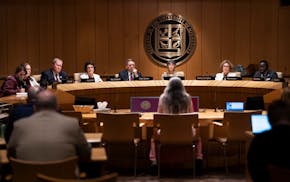Let me tell you about my friends, the Robinsons.
At least I like to think of the Robinsons as friends — in some cosmic way. We do share a bathtub.
Harry and Clementine Robinson lived in my southwest Minneapolis home a century ago. They were Black, and their presence in what is now the whitest part of the city was controversial. I learned these facts when my husband and I — who are both white — moved into the house in March 2020.
The pandemic locked us in our 113-year-old home, and I kept thinking about the Robinsons. Who were they? Where did they come from? Where did they end up?
I have been obsessively sleuthing for nearly five years. And I'm finally ready to tell the Robinsons' remarkable story, with audio producer Melissa Townsend, in the Minnesota Star Tribune's first narrative podcast, "Ghost of a Chance." The investigation began as a little mystery about my house, but it ultimately revealed an important history of race in Minneapolis.
Recently digitized Black newspapers allowed me to find granular details about social gatherings and other major events in the Robinsons' lives. These and other digitized records — like city directories — surfaced information that would have been difficult or impossible to find in the past.
I probed census data and other historical information on Ancestry.com. The Robinsons did not have children, but I connected with several of their distant relatives.
To learn about the Robinsons' origin stories, I drove across the Midwest to the small towns in Missouri and Indiana where Clementine and Harry grew up. Local historians were excited to help with the project. The unofficial historian of Clementine's rural hometown shared memories with me for hours at a nursing home, just three months before his death.
I pored over records at the Minnesota History Center, Minneapolis City Hall, Hennepin County Library, the Hennepin County courthouse and even an obscure warehouse of city records behind an unmarked entry in an industrial business park. My fingertips got dirty as I leafed through giant ledger books, and I struggled to remain focused as I scrolled through reels of microfilm.
Many days I found nothing.
Other days brought moments of discovery that gave me a jolt of energy. One find caused me to rise from my chair and exclaim "yes!" amid the quiet of the Gale Family Library. My editor and I high-fived when I located a photo of Clementine after three years of searching.
A personal discovery
I did not expect that the most significant undertaking of my career would be about race. The topic hadn't been a focus of mine as a journalist.
A little bit about me: I grew up on the Upper East Side of New York City. I have worked for the Star Tribune since I graduated from college in 2009 — and have become a devotee of Minnesota and Minneapolis. My passion for writing about history is how I came to lead our Curious Minnesota project.
I had not spent much time talking or thinking about race, perhaps because my social circle is largely white. I actually bristle at elements of today's culture that reduce people's identity to their race, gender or sexual orientation.
In the wake of George Floyd's murder, I remained quiet as the world scrutinized Minneapolis. The message seemed to be that something was rotten here that had left Black people behind. Police brutality, racial covenants, destructive freeways — a lot had happened in the city. But it also felt like I was being asked to accept an oversimplified narrative about the past.
My curiosity about the Robinsons provided a path for me to investigate the history on my own terms and really dig into the details.
As I pieced together their stories, it became clear that there is a compelling history here. The Robinsons' lives were a window into the injustices that Black people faced in Minnesota, injustices that have been easier to ignore because the state did not have Jim Crow laws. And though we are more enlightened today, this history is still having ripple effects.
Over time, my work grew into a full-blown newsroom endeavor. Melissa Townsend joined the project and spent more than a year transforming my research into a gripping audio series.
We held listening sessions and attended community events to incorporate memories and the feedback of south Minneapolis' Black residents. I left those discussions encouraged by people's openness and generosity.
This journey has also forced me to confront some tough facts about a neighborhood I truly love.
The southwest community of Minneapolis around Lake Harriet is more than 80% white. It came as a surprise to me how intentional the effort was to make it that way. Most notably for the Robinsons, two hundred of their neighbors gathered in 1920 to rid that corner of the city of roughly nine Black families. The meeting was five blocks from the Robinsons' home.
This all happened a long time ago, of course. But the early 20th century was also a key moment when the first generation of Black people born free from slavery could have built wealth and passed it on to future generations. Instead they were held back and hemmed into segregated neighborhoods.
When I presented this project two years ago to Star Tribune editor Suki Dardarian, she said she wanted to start a community conversation.
So please give it a listen, and let us know what you think at ghostofachance@startribune.com.
I will never meet the Robinsons, but an old house has connected us across generations. I have peered through the same wavy-glass windows, lain awake at night in the same bedroom, and relaxed in the same claw-foot bathtub.
I won't forget about the challenges they endured. I hope you won't, either.
The first episodes of "Ghost of a Chance" will be released Jan. 13 and will be available wherever you get your podcasts.
Things to know about the retrial of Karen Read in the killing of her police officer boyfriend

Foundation submitted voter registration applications with fake IDs, charges say

University of Minnesota faculty and students urge Regents to reject budget cuts and tuition hikes

Teenage boy arrested in connection with fatal shooting outside Northtown Mall

